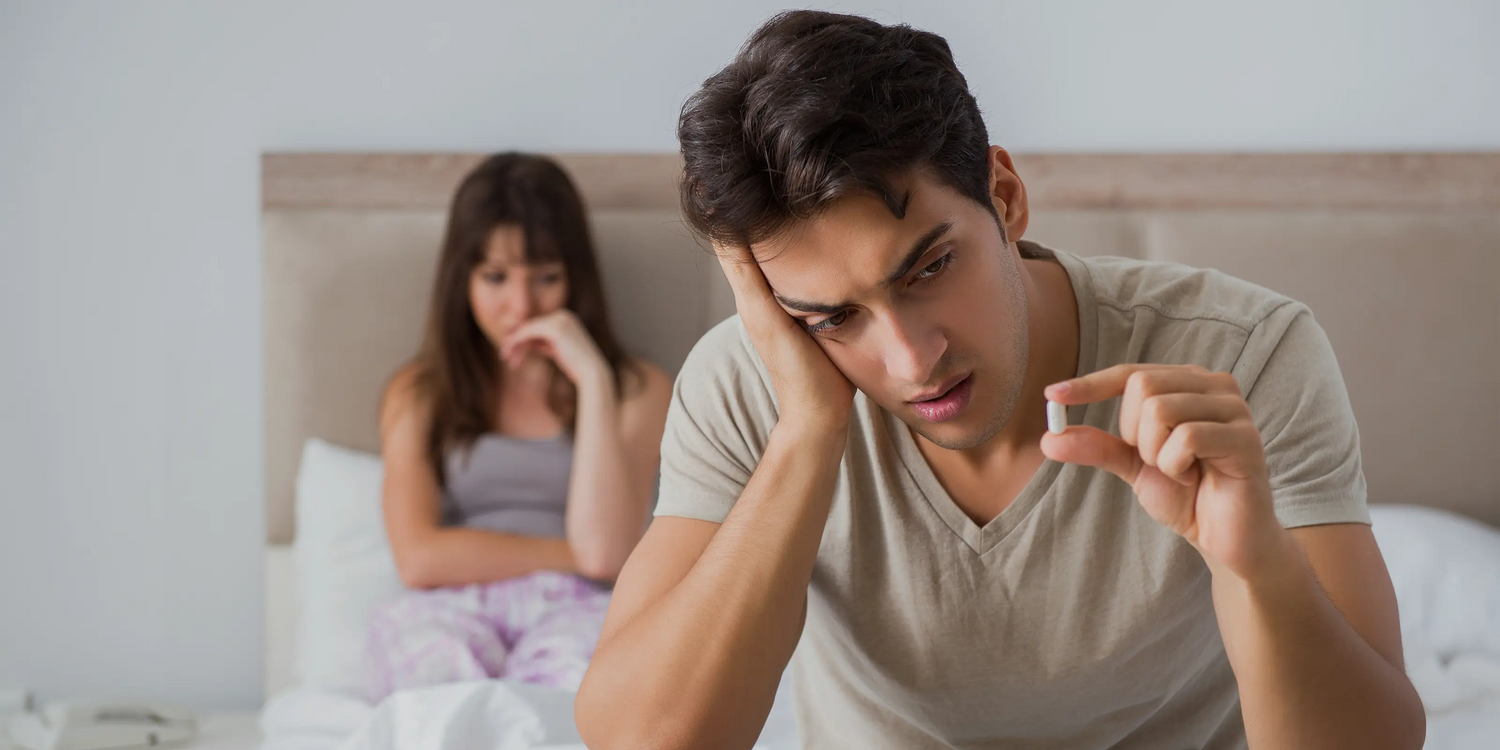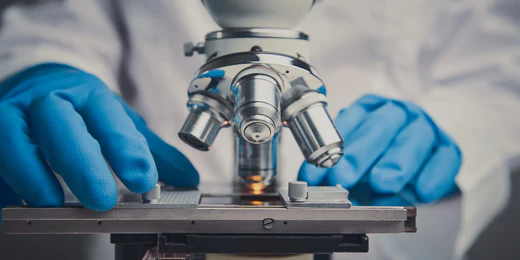Let's take the time to separate the facts from fiction when it comes to side effects of finasteride, so that you can make the most informed decision about what’s right for you. We’ve also consulted Dr. Christina Han, a board-certified dermatologist and Medical Director at XYON for her expert advice on how to minimize these potential risks and still reach your hair goals.
How common are finasteride side effects?
Studies have reported different ranges when it comes to the frequency of side effects like erectile dysfunction and decreased libido (lowered sex drive). However, there’s at least some consensus within the medical community that sexual side effects are the most common type of side effect, occurring in about 2.1-3.8% of individuals taking finasteride for hair loss compared to placebo (Mysore, 2012). According to one early study, sexual side effects are about twice as likely to occur in the finasteride treatment group compared to the placebo group (Kaufman et al., 1998).
When it comes to specific issues within this category, the top three most common sexual side effects are erectile dysfunction (3.4-15.8% of cases), decreased libido (2.36-10% of cases) and ejaculatory disorders (0.9-5.75 of cases) (Hirshburg et al., 2016).
The most common side effects associated with taking finasteride are sexual side effects, but the medication has also been linked to adverse effects affecting other parts of the body. Here are some of the more common and less common side effects of finasteride:
- Erectile dysfunction
- Changes in sex drive (decreased libido)
- Gynecomastia (breast swelling and/or tenderness)
- Breast pain
Less common side effects of finasteride include:
- Decreased ejaculatory volume
- Lowered sperm count
- Depression
- Suicidal ideation
- High-grade prostate cancers
Sexual side effects of finasteride
Why does finasteride cause sexual side effects? We think it’s important to try to understand what’s happening in the body on a physiological level before panicking.
Let's refresh ourselves on how finasteride works. Finasteride is a medication called a 5-alpha reductase inhibitor (5-ARI), which is designed to block the body from producing a hormone called dihydrotestosterone (DHT). If you take finasteride per your doctor’s dosage instructions, the medication helps lower DHT levels (and keeps them lowered) to protect hair follicles from undergoing a process called follicular miniaturization which can, over time, lead to thinning hair and patchiness.
But DHT isn't a bad hormone. In fact, male bodies require DHT and other androgens to maintain optimal health. The prostate gland, male genitalia and brain are also sensitive to changes in DHT concentrations. Finasteride doesn’t cause these changes directly, but they can happen because of body-wide reductions in DHT levels, which can be a concern when someone chooses to take the oral form of finasteride.
Possibly. A few studies have been conducted to assess the relationship between androgen levels and sexual function in men. In one trial where participants are supplemented with androgen therapy, there were positive effects on erectile function and sex drive, but study authors also stated that it wasn’t clear how low androgen levels needed to be before impaired sexual function was noticeable (Traish et al. 2010).
A separate study found that men who started off with lower baseline testosterone levels experienced more sexual side effects while taking finasteride compared the men who had normal testosterone levels (Marberger, 1998). This tells us that there are other factors at play when assessing someone’s risk for developing sexual side effects.
Finasteride and lowered sex drive: is there a link?
Again, the answer here is “possibly”. Changes in sex drive have been reported by men (and women) taking finasteride for hair loss. Because drugs like finasteride and dutasteride work by lowering concentrations of DHT in the body, this also means that chemical reactions that use DHT might be impacted.
DHT is an important precursor molecule used to make neuroactive steroids. These steroids participate in reactions in the brain that help regulate mood, pleasure and motivation. In fact, over a dozen clinical studies exist that back the role of these neuroactive steroids in maintaining normal brain function (Traish, 2020). Based on these findings, some researchers have attributed changes in sex drive to lowered DHT and therefore, decreased production of these neuroactive steroids.
Does finasteride cause depression?
Like sexual side effects, increased anxiety and depression have also been associated with finasteride treatment. To clarify, the evidence doesn’t point to finasteride use as a direct cause for depression, but again, as in the case of changes in sex drive, the medication could be lowering concentrations of important precursor molecules that help regulate certain brain pathways that control mood.
One study examined blood and cerebrospinal fluid (CSF) for levels of these precursor molecules and found that people who had taken finasteride showed changes in the concentrations of these substances, which were associated with depressive symptoms (Caruso et al., 2015). Interestingly, these changes in the body were detectable even after study participants stopped taking finasteride.
Are the side effects of finasteride permanent?
The short answer is that it’s unlikely, but not impossible. In many cases, patients who take finasteride and experience side effects will fully recover from these after stopping the medication. Finasteride is designed to lower DHT levels and with consistent dosing, help maintain this new lower level of DHT. If you stop taking finasteride, DHT concentrations will slowly return to their pretreatment levels. This usually means relief from sexual side effects.
There have also been studies of long-term finasteride use that have found that if patients stick with treatment, the incidence of initial side effects goes down over time. For some individuals, it might mean giving the body some extra time to adjust to treatment.
Sexual dysfunction can be difficult to talk about, but Dr. Han encourages physicians to be sensitive to the concerns of their patients and patients to feel like they can be open about their experiences:
“One of the challenges with side effects like sexual dysfunction is that the cause can be multifactorial. There can be a variety of factors that come into play with sexual functioning such as cardiovascular health, use of certain mood stabilizers such as antidepressants and age. But we also need to keep in mind that there are psychological aspects. Mood and stress levels can impact arousal and overall sexual performance. Even the mention of possible sexual dysfunction as a possible side effect can cause anxiety leading to impacts in sexual functioning. When navigating these potential factors when it comes to sexual dysfunction, I always recommend working with a healthcare professional in the specific area that you need support in.”
In cases where side effects continue even after coming off finasteride, it’s important to work closely with your physician to review whether there might be anything in your medical history that could be contributing to side effects. If you want to learn more about long term side effects of finasteride, we encourage you to visit our article on post-finasteride syndrome.
Does finasteride cause cancer?
Not directly, but it might complicate the diagnosis of certain types of cancer. In the last decade, there have been several studies looking into the impact of 5-alpha reductase inhibitors like finasteride on prostate health. These medications are also commonly prescribed to help alleviate symptoms associated with an enlarged prostate, also known as benign prostatic hyperplasia (BPH).
Research has shown that by lowering DHT levels within the prostate gland, finasteride can help reduce the overall size of the prostate gland. This is good news for patients with BPH and has also proven to be useful in lowering the incidence of less-aggressive forms of prostate cancer. However, because it shrinks the size of the prostate gland, finasteride may also make it more difficult to catch more aggressive forms of prostate cancer using the biopsy method. You can learn more about the impacts of finasteride on prostate health and prostate cancer risks by visiting our article.
How to reduce side effects of finasteride
For those worried about side effects of finasteride, Dr. Han recommends the following:
“Talking to your doctor about trying alternate formats such as topicals may help to reduce the risk of developing side effects. Topical formulations allow for more localized application to the areas that need treatment the most and may offer more reassurance for those worried about side effects. At the end of the day, every medication has the potential for side effects and while most side effects are fortunately rare and reversible, it will all come down to patient preference, motivation to treat their condition and tolerance for risk.”
Does topical finasteride have side effects?
All medicated treatments have the potential to cause side effects. However, when compared to oral finasteride, topical finasteride has been associated with a lower risk of side effects (Lee et al., 2018). This may be because less drug enters the bloodstream.
XYON’s SiloxysSystem™ Gel delivery system is an advanced topical base designed to reduce absorption of active ingredients like finasteride. It works by helping to control how quickly and how much medication enters the skin. For some people, this more consistent dosing could be beneficial in lowering overall exposure and safety risks, without affecting efficacy.
When topical finasteride is applied to the scalp, the gel forms a film or mesh-like layer on top of the skin. This mesh helps hold finasteride in place, releasing it gradually into the skin based on how much medication is already in the scalp. In this way, the gel helps deliver the right amount of finasteride to the hair follicles at a rate they can use up.
In clinical studies, SiloxysSystem™ Gel was found to lower finasteride concentrations in the blood by 92% compared to an FDA reference value for the oral tablet. It also helped keep 10-17x more finasteride contained in the skin and out of the bloodstream. The result? Potentially fewer side effects.
What should I do if I experience side effects while taking finasteride?
Side effects while taking finasteride can be concerning. But there are a few things you can do to ensure that you’re prioritizing your health and safety throughout treatment:
-
Talk to a doctor.
If you think you might be experiencing side effects while taking finasteride, the first step is to notify a healthcare professional. Depending on your situation, they may suggest changing the dosage of finasteride or trying a different treatment altogether to avoid side effects. -
Lower the dose.
Your doctor could also recommend trying a lower dose of finasteride. Less medication in the bloodstream may help reduce the risk of developing side effects. Never try to alter dosing yourself, but you can bring this to your doctor’s attention. -
Consider your options.
Instead of the oral drug, you might consider using topical finasteride. Topical forms of finasteride are referred to as compounded medications and are typically prepared by specialized compounding pharmacies based on a doctor’s prescription. An example would be finasteride compounded in XYON’s SiloxysSystem™ Gel base. This format allows finasteride to be applied directly to the skin and could help minimize unnecessary exposure to the drug. Remember, a doctor will need to determine if topical finasteride is right for you.
Finasteride side effects: takeaway
Every medication comes with a risk of side effects and finasteride is no exception. If you’re using finasteride for hair loss, it's important to maintain regular communication with your doctor and let them know if you think you might be experiencing side effects. While rare, sexual side effects are the most common type of side effect reported by finasteride users. In many cases, these will go away with continued use of the medication, or by stopping the medication altogether. Finally, if you’re concerned about side effects, consider talking to your doctor about whether topical finasteride might be a reasonable option for you.
References list
Caruso, D., Abbiati, F., Giatti, S., Romano, S., Fusco, L., Cavaletti, G., & Melcangi, R. C. (2015). Patients treated for male pattern hair with finasteride show, after discontinuation of the drug, altered levels of neuroactive steroids in cerebrospinal fluid and plasma. The Journal of Steroid Biochemistry and Molecular Biology, 146, 74–79. https://doi.org/10.1016/j.jsbmb.2014.03.012
Hirshburg, J. M., Kelsey, P. A., Therrien, C. A., Gavino, A. C., & Reichenberg, J. S. (2016). Adverse effects and safety of 5-alpha reductase inhibitors (finasteride, dutasteride): a systematic review. The Journal of Clinical and Aesthetic Dermatology, 9(7), 56–62.
Traish, A. M., & Gooren, L. J. (2010). Safety of physiological testosterone therapy in women: lessons from female-to-male transsexuals (FMT) treated with pharmacological testosterone therapy. The Journal of Sexual Medicine, 7(11), 3758–3764. https://doi.org/10.1111/j.1743-6109.2010.01962.x
Traish, A. M (2020). Post-finasteride syndrome: a surmountable challenge for clinicians. Fertility and Sterility. 113(1), 21-50.
Kaufman, K. D., Olsen, E. A., Whiting, D., Savin, R., DeVillez, R., Bergfeld, W., Price, V. H., Van Neste, D., Roberts, J. L., Hordinsky, M., Shapiro, J., Binkowitz, B., & Gormley, G. J. (1998). Finasteride in the treatment of men with androgenetic alopecia. Finasteride Male Pattern Hair Loss Study Group. Journal of the American Academy of Dermatology, 39(4 Pt 1), 578–589. https://doi.org/10.1016/s0190-9622(98)70007-6
Lee, S. W., Juhasz, M., Mobasher, P., Ekelem, C., & Mesinkovska, N. A. (2018). A systematic review of topical finasteride in the treatment of androgenetic alopecia in men and women. Journal of Drugs in Dermatology: JDD, 17(4), 457–463.
Marberger M. J. (1998). Long-term effects of finasteride in patients with benign prostatic hyperplasia: a double-blind, placebo-controlled, multicenter study. PROWESS Study Group. Urology, 51(5), 677–686. https://doi.org/10.1016/s0090-4295(98)00094-6
Mysore V. (2012). Finasteride and sexual side effects. Indian Dermatology Online Journal, 3(1), 62–65. https://doi.org/10.4103/2229-5178.93496
Traish, A. M., & Gooren, L. J. (2010). Safety of physiological testosterone therapy in women: lessons from female-to-male transsexuals (FMT) treated with pharmacological testosterone therapy. The Journal of Sexual Medicine, 7(11), 3758–3764. https://doi.org/10.1111/j.1743-6109.2010.01962.x
Traish, A. M (2020). Post-finasteride syndrome: a surmountable challenge for clinicians. Fertility and Sterility. 113(1), 21-50.




